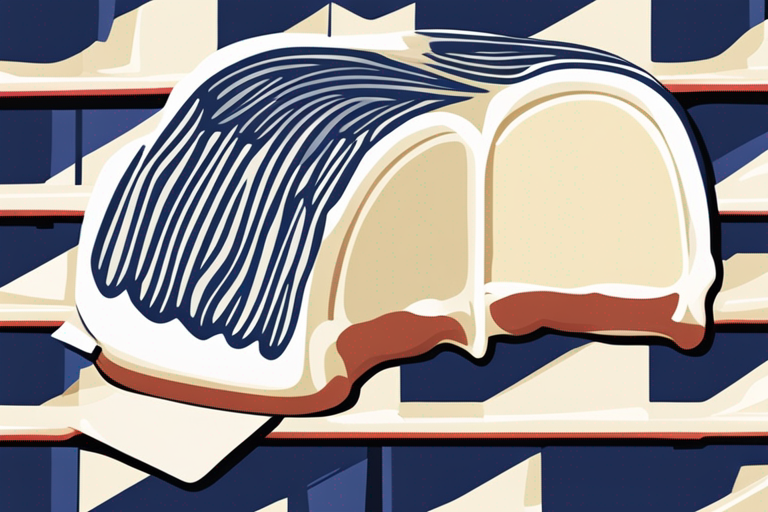
The Ultimate Guide to Cream Cheese Expiration Date Unopened
Get Your Free Food Safety Cheat Sheet
30 most common foods with instant answers. Print it and stick it on your fridge—completely free!
# The Ultimate Guide to Cream Cheese Expiration Date Unopened
Cream cheese is a versatile and creamy dairy product loved by many for its rich taste and smooth texture. Whether you use it to spread on bagels, bake into cheesecakes, or mix into dips, cream cheese is a staple in many kitchens. But like all perishable foods, cream cheese has an expiration date. In this comprehensive guide, we will explore everything you need to know about the expiration date of unopened cream cheese.
## What Does the Expiration Date on Cream Cheese Mean?
Cream cheese, like other dairy products, comes with a "sell-by" or "use-by" date stamped on the packaging. But what exactly does this date signify? Here's a breakdown:
### Sell-By Date
The sell-by date on cream cheese is a guideline for retailers, indicating the last day the product should be sold. It is not a strict indicator of the product's freshness or safety. Consumers can typically consume cream cheese for some time after the sell-by date if stored properly.
### Use-By Date
The use-by date is a recommendation from the manufacturer for when the cream cheese should be consumed for the best quality. Consuming the product after the use-by date may not be harmful, but the taste and texture may deteriorate.
## Factors Affecting Cream Cheese Shelf Life
Several factors can influence the shelf life of unopened cream cheese. Understanding these factors can help you determine if your cream cheese is still safe to eat:
### Storage Conditions
Proper storage is crucial in prolonging the shelf life of cream cheese. Here are some tips for optimal storage:
- Keep cream cheese refrigerated at all times.
- Store cream cheese in its original packaging or an airtight container.
- Avoid storing cream cheese near foods with strong odors, as it can absorb flavors.
### Temperature
Cream cheese should be stored at a consistent temperature to maintain its quality. The ideal temperature for storing cream cheese is between 35-40°F (1.6-4.4°C).
### Packaging
The packaging of cream cheese plays a significant role in its shelf life. Unopened cream cheese in a sealed container will last longer than cream cheese that has been exposed to air.
## Signs of Spoiled Cream Cheese
Even if your cream cheese is within the expiration date, it's essential to check for signs of spoilage before consuming it. Here are some indicators that your cream cheese may have gone bad:
### Mold
If you notice any mold growth on the surface of the cream cheese or around the edges, it's time to discard it. Mold can produce harmful toxins and should not be consumed.
### Off Odor
Spoiled cream cheese may have a sour, rancid, or off-putting odor. If it smells unpleasant, it's best to err on the side of caution and discard it.
### Texture Changes
Cream cheese that has become watery, slimy, or grainy in texture is likely spoiled. Fresh cream cheese should have a smooth and creamy consistency.
## How Long Does Unopened Cream Cheese Last?
Unopened cream cheese can last beyond the expiration date if stored properly. Here's a general guideline for the shelf life of unopened cream cheese based on storage conditions:
- Refrigerator (35-40°F or 1.6-4.4°C): 2-3 weeks past the sell-by date
- Freezer (0°F or -17.8°C): Up to 6 months
It's important to note that these are estimates, and the actual shelf life may vary depending on various factors.
## Real-Life Scenarios
Understanding the expiration date of cream cheese can be particularly relevant in everyday situations. For example, consider Sarah, who was preparing for a small gathering with friends. She had some cream cheese left over from a previous baking session. The sell-by date was approaching, but she wasn’t sure if it was still good. Remembering to check for mold and sniffing it for any off smells, she decided to use the cream cheese in a dip. It turned out delicious, and her friends loved it. If Sarah hadn’t checked closely, she could have easily tossed out perfectly good cream cheese.
Another scenario involves Mike, who loves to bake cheesecakes. He often buys cream cheese in bulk to save money. However, he sometimes forgets about the older packs in the back of his fridge. During a recent baking day, he found a pack that had passed its use-by date. Instead of immediately discarding it, he checked for any signs of spoilage. Though it was just a few days past the date, the cream cheese was still fresh and creamy, allowing him to create a fantastic cheesecake that impressed everyone at dinner.
## The Science Behind Cream Cheese Preservation
Cream cheese is a dairy product that is often pasteurized, which helps kill harmful bacteria and extend its shelf life. The acidity level in cream cheese, which is influenced by the fermentation process, also plays a significant role in its preservation. Lower pH levels discourage the growth of spoilage bacteria, making cream cheese a bit more resilient than other dairy products.
However, once opened, cream cheese is more susceptible to spoilage because it can be exposed to air and various bacteria from utensils or hands. It's crucial to minimize contact with contaminants. Using a clean knife and ensuring that the cream cheese is always sealed tightly will help maintain its quality for as long as possible.
## Practical Tips for Storage and Use
Here are some actionable tips to ensure your cream cheese lasts longer and maintains its flavor:
1. **Avoid Temperature Fluctuations**: Try to store cream cheese in the main part of the refrigerator, rather than in the door, which is subject to temperature changes when opened frequently.
2. **Freeze for Later Use**: If you buy cream cheese in bulk or won’t use it all before the expiration date, consider freezing it. While the texture may change slightly after thawing, it’s perfectly safe for cooking and baking.
3. **Portion Control**: If you often use cream cheese in smaller quantities, consider dividing it into smaller portions before freezing. This way, you can thaw only what you need without wasting any.
4. **Label Your Packages**: If you're freezing cream cheese, label the packages with the date you froze them. This can help you keep track of how long they’ve been in the freezer.
5. **Creative Uses**: Last but not least, don’t forget that cream cheese can be used for more than just spreads or dips. You can incorporate it into pasta sauces, soups, or even as a base for creamy dressings.
## Common Mistakes People Make
Many people underestimate the importance of proper storage. One common mistake is leaving cream cheese out at room temperature for extended periods. Even though it may be tempting to leave it out for easy access, doing so can lead to faster spoilage. It’s crucial to return it to the refrigerator promptly after use.
Another mistake involves ignoring the sensory checks. Just because it's past the expiration date doesn’t automatically mean it’s bad. However, many consumers throw out unopened cream cheese simply because the date has passed, without checking for mold or odor.
## Expert Insights
Food safety experts recommend always erring on the side of caution. As a general rule, if you're ever in doubt about the safety of any food product, including cream cheese, it’s better to discard it. Eating spoiled dairy can lead to foodborne illnesses, which can be severe in some individuals, especially those with compromised immune systems.
Additionally, if you encounter cream cheese that has separated, simply stirring it can sometimes restore its texture. However, if it looks curdled or has a distinctly sour smell, it’s best to throw it away.
## Safety Warnings
Pay attention to the "check before you spread" mantra. Always inspect your cream cheese before using it, especially if you’ve had it for a while. Be cautious about using cream cheese in recipes for pregnant women, young children, or those with weakened immune systems. It’s crucial to prioritize safety and quality over convenience.
## Conclusion
In conclusion, understanding the expiration date of unopened cream cheese is essential for maintaining food safety and quality. By following proper storage guidelines, checking for signs of spoilage, and being mindful of storage conditions, you can enjoy your cream cheese safely and deliciously. Remember, when in doubt, it's best to discard cream cheese that shows signs of spoilage to prevent foodborne illness. By being informed and proactive, you can make the most of your cream cheese while ensuring your health and well-being. Now that you have a deeper understanding of cream cheese storage and safety, go ahead and enjoy all the creamy delights it has to offer!

Authoritative Food Safety References
These agencies and university labs inform every tip and health precaution we publish.
USDA FoodKeeper – Cold Storage Guidelines
Official refrigerator, freezer, and pantry timelines maintained by the U.S. Department of Agriculture.
Visit USDA FoodKeeperFDA Produce Safety Rule & Grower Guidance
Field-to-fridge handling practices that prevent contamination of fruits, vegetables, and leafy greens.
Visit FDA Produce SafetyCDC Foodborne Illness Prevention Hub
Surveillance-backed guidance on pathogens, symptoms, and steps to reduce foodborne illness risk.
Visit CDC Food SafetyUC Davis Postharvest Technology Center
University research detailing optimal storage atmospheres for produce after harvest.
Visit UC Davis PostharvestPenn State Extension – Home Food Preservation & Safety
Peer-reviewed extension bulletins on safe canning, chilling, and reheating practices.
Visit Penn State ExtensionWhat is the shelf life of unopened cream cheese?
Can I use cream cheese past its expiration date if unopened?
How can I tell if unopened cream cheese has gone bad?
Can unopened cream cheese be frozen to extend its shelf life?
Is it safe to eat unopened cream cheese if it has been stored in the refrigerator for a long time?
Get Your Free Food Safety Cheat Sheet
30 most common foods with instant answers. Print it and stick it on your fridge—completely free! Want more? Upgrade to the complete guide with 70+ foods.
Scan your food directly and get instant safety info using our AI-powered camera feature.